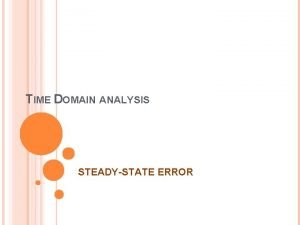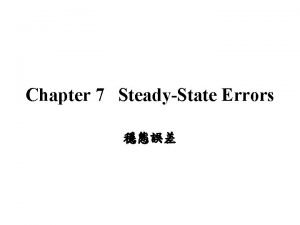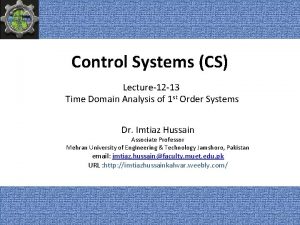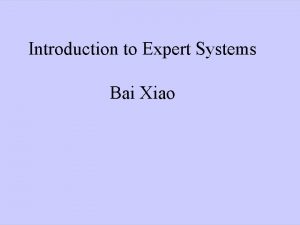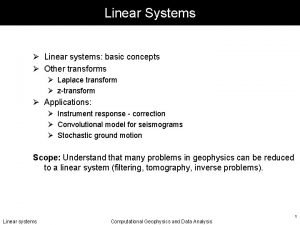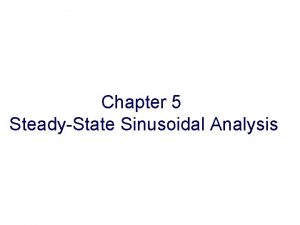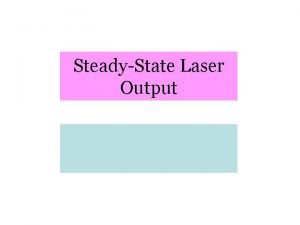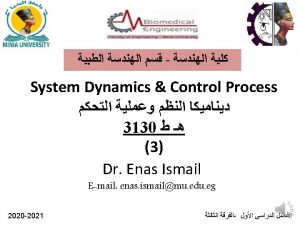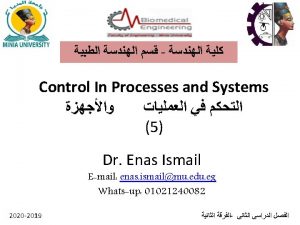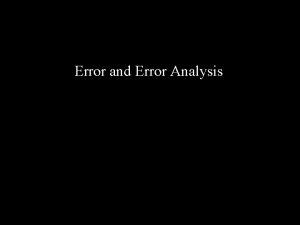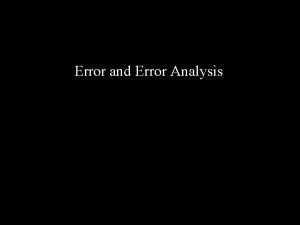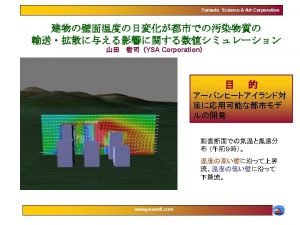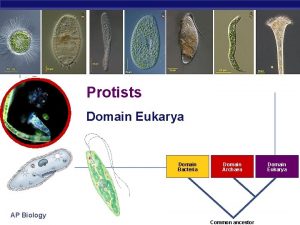TIME DOMAIN ANALYSIS STEADYSTATE ERROR STEADYSTATE ERROR The















- Slides: 15

TIME DOMAIN ANALYSIS STEADY-STATE ERROR

STEADY-STATE ERROR The difference between the output and the reference in the steady state was defined as the steady-state error. In the real world, because of friction and other imperfections and the natural composition of the system, the steady state of the output response seldom agrees exactly with the reference. Therefore, steady-state errors in control systems are almost unavoidable. In a design problem, one of the objectives is to keep the steady-state error to a minimum, or below a certain tolerable value.

STEADY-STATE ERROR OF LINEAR CONTINUOUS-DATA CONTROL SYSTEMS where r(t) is the input; u{t), the actuating signal; b{t), the feedback signal; and y(t), the output. The error of the system may be defined as e{t) = reference signal—y(t) The steady-state error (ess) is defined as

Example: Ø consider a velocity control system in which a step input is used to control the system output that contains a ramp in the steady state. let K = 10 volts/rad/sec Then, The closed-loop transfer function of the system is

Cont…… Ø For a unit-step function input, R(s) = l/s. The output time response is Ø . Thus, the steady-state error of the system is It is known that the referential signal is ramp which is 0. 1 t. Ø To establish a systematic study of the steady-state error for linear systems, we shall classify three types of systems and treat these separately. Systems with unity feedback; H(s) = 1. Ø Systems with nonunity feedback, but H(s) = KH — constant. Ø Systems with nonunity feedback, and H(s) has zeros at s = 0 of order N. Ø

TYPE OF CONTROL SYSTEMS: UNITY FEEDBACK SYSTEMS The steady-state error of the system is written Clearly, ess depends on the characteristics of G(s). we can show that ess depends on the number of poles G(s) has at s = 0. This number is known as the type of the control system or, simply, system type. E. g.

STEADY-STATE ERROR OF SYSTEM WITH A STEP-FUNCTION INPUT When the input to the control system with H(s) = 1 is a step function with magnitude R, R(s)=R/s, the steady-state error is let’s say Therefore, the steady-state error is Ø we can summarize the steady-state error due to a step function input as follows: Type 0 system: =constant Type 1 or higher system: ess = 0

STEADY-STATE ERROR OF SYSTEM WITH A RAMP-FUNCTION INPUT When the input is a ramp function with magnitude R, where R is a real constant, the Laplace transform of r{t) is The steady-state error is Let’s define the ramp-error constant as Therefore, and the ess Type 0 system: ess = Type 1 system: ess = = constant Type 2 system: ess = 0

STEADY-STATE ERROR OF SYSTEM WITH A PARABOLIC-FUNCTION INPUT When the input is described by the standard parabolic form = The steady-state error of the system Defining the parabolic-error constant as The steady state error become: � Type 0 system: ess = � Type 1 system: ess = ess= =constan t � Type 3 or higher system: ess = 0 � Type 2 system:

RELATIONSHIP BETWEEN STEADY-STATE ERROR AND CLOSEDLOOP TRANSFER FUNCTION the closed-loop transfer function can be used to find the steady-state error of systems with unity as well as non-unity feedback. � let us impose the following condition: � we can define the reference signal as r(t)/KH and the error signal as � in the transform domain, � where M{s) is the closed-loop transfer function

The steady-state error of the system is Substituting M(s) into the last equation and simplifying, For the three basic types of inputs for r(t). 1. Step-function input. R{s) = R/s. � the steady-state error due to a step input can be zero only if • or

2. Ramp-function input. R{s) = R/s. � For a ramp-function input, the steady-state error � The following values of ess are possible 3. Parabolic-function input. R(s) = R/s � the steady-state error � The following values of ess are possible

Example Consider that the system has the following transfer functions: And The closed loop TF is

STEADY-STATE ERROR OF NON-UNITY FEEDBACK: H(S) HAS NTH-ORDER ZERO AT S = 0 In the real world, this corresponds to applying a tachometer or rate feedback. Thus, for the steady-state error analysis, the reference signal can be defined as the error signal in the transform domain may be defined as where, The steady-state error for N = 1 is written as For a step input of magnitude R

EXAMPLE 5 -4 -6 Consider that the system has the following transfer functions: And The closed loop transfer function is
 Steady state error
Steady state error Unity feedback system
Unity feedback system Fourier series of trapezoidal waveform
Fourier series of trapezoidal waveform Control system
Control system Codomain vs range
Codomain vs range Z domain to frequency domain
Z domain to frequency domain Time reversal z transform
Time reversal z transform Z transform tutorial
Z transform tutorial Domain specific vs domain general
Domain specific vs domain general Domain specific software engineering
Domain specific software engineering Problem domain vs knowledge domain
Problem domain vs knowledge domain S domain to z domain
S domain to z domain Application domain and execution domain
Application domain and execution domain Elapsed time
Elapsed time Difference between error analysis and contrastive analysis
Difference between error analysis and contrastive analysis Contrastive analysis error analysis and interlanguage
Contrastive analysis error analysis and interlanguage
